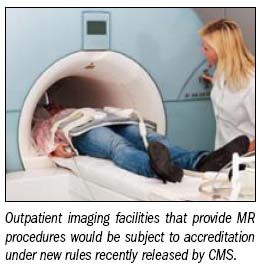CMS backs opposing imaging center accreditation plans
They couldn't be more different in their approach to accrediting radiology imaging centers.
They couldn't be more different in their approach to accrediting radiology imaging centers. The American College of Radiology and the Joint Commission were both approved by CMS to accredit centers that offer advanced imaging (CT, MR, nuclear medicine, and PET procedures), a requirement that will begin in 2012. CMS also approved the Intersocietal Accreditation Commission, which offers a program very similar to the one run by the ACR.
Although it might seem like inside baseball to many radiologists, mandatory accreditation of facilities is a new frontier for advanced imaging. The ACR lobbied for the requirement in 2008 legislation that authorized the program. Radiology advocates contend accreditation could improve quality and control the self-referred imaging that is helping drive imaging overutilization.
How the different approaches would affect imaging overutilization is a matter of conjecture, but it's clear that they have widely differing strategies for approaching the quality question. In the case of the ACR and the ICR, the key focus is on image quality. The Joint Commission, on the other hand, approaches imaging as an outgrowth of its other quality assurance programs and applies pretty much the same framework.
“Our philosophy is that image quality is the measure of the entire system,” said Pam Wilcox, the ACR's assistant executive director of Quality and Safety.

That means phantom testing of imaging equipment and requiring standards of training and procedure volume in a modality for technologists who collect the images and medical physicists who oversee them, and for supervising radiologists. The ACR's program will also have a peer-review element.
Launched in 1963, the ACR's program has evolved over time. A big change occurred the 1980s, in part prompted by issues around breast imaging that made the organization realize it needed to focus on what makes a good image in each modality, Wilcox said. Mammography images that would have passed muster in 1987-88 would not be approved today.
The IAC accreditation programs offer an intersocietal approach in assuring that the right people are performing and interpreting the right tests. To ensure quality, primary emphasis is placed on the evaluation of the images, said Tamara A. Sloper, director of marketing for the IAC. Pathology is required and the corresponding final reports are closely critiqued.
Michael Kulczycki, executive director for the Joint Commission's Ambulatory Accreditation Program, characterized his organization's approach as “organization-wide and focused on systems and processes.”
“You create an environment where you are not spreading infections and you ask whether they have prevention steps in place. We focus on overall patient and staff safety; in an imaging center are there systems for hazardous waste disposal and fire protection,” he said.
The Joint Commission also eschews a peer-review requirement.
“We say there are published expectations of what makes a good provider and we evaluate against what are recognized as safe practices,” Kulczycki said.
He also noted that peer review is part of the recredentialling of physicians.
Another difference is in pricing and could help determine the relative success of the two programs. The ACR charges by modality. The Joint Commission will offer a volume pricing plan, something Kulczycki said was viewed favorably by CMS and could be attractive to rural, lower volume providers.
Both Wilcox and Kulczycki said their programs would be competitive in price, although Kulczycki suggested that for two modalities, the ACR would offer the more cost-effective option and for four, the more expensive.
One thing the Joint Commission approach probably won't do is cut down on self-referred imaging. The ACR's approach would require facility medical directors to be physicians with training or experience in radiology. The Joint Commission approach makes credentialing possible for any facility that bills for the technical component of the fee. (For more on this topic, see a commentary by Thomas Greeson posted Jan. 28 at the Radiology in Practice segment of diagnosticimaging.com.)
Newsletter
Stay at the forefront of radiology with the Diagnostic Imaging newsletter, delivering the latest news, clinical insights, and imaging advancements for today’s radiologists.